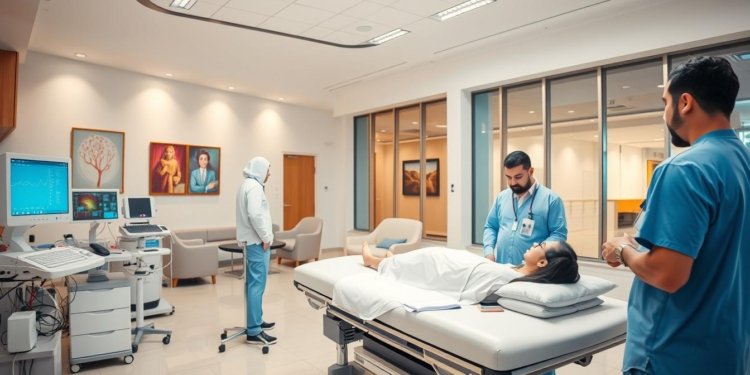Cardiovascular diseases remain a leading cause of concern globally, with millions affected each year. In the Middle East, the need for specialized care and awareness is growing rapidly. The Saudi Heart Association plays a pivotal role in addressing these challenges, combining clinical expertise with nationwide health initiatives.
As the foremost authority in cardiovascular health, the organization drives research, education, and preventive programs. Its efforts align with broader national goals, ensuring better health outcomes for communities across the region. Through collaborations and training, it sets new standards in cardiac care.
Key Takeaways
- Leading authority in cardiovascular health and education
- Supports national health objectives under Vision 2030
- Runs multiple research and public awareness initiatives
- Provides specialized training for medical professionals
- Enhances preventive care to improve quality of life
About the Saudi Heart Association
Focused on improving cardiac care, this group leads critical initiatives across the region. The Saudi Heart Association unites experts to combat cardiovascular diseases through research, education, and community programs. Its influence extends nationwide, shaping policies that prioritize patient well-being.
Mission and Vision
The organization aims to reduce heart-related deaths by promoting prevention and cutting-edge treatments. By 2025, it strives to be the Middle East’s top hub for cardiac research. Over 15 accredited training centers support this goal, equipping professionals with life-saving skills.
Role in Saudi Arabia’s Healthcare System
Working with the National Heart Center and Saudi Health Council, the association strengthens the country’s health infrastructure. It co-develops disease prevention guidelines with the Saudi CDC and heads the National CPR Committee. These efforts align with Saudi Arabia’s Vision 2030, ensuring a healthier future for all.
Journal of the Saudi Heart Association
Advancing cardiac research, the Journal of the Saudi Heart Association serves as a cornerstone for medical professionals. It publishes original studies, case reports, and letters in English, fostering global knowledge exchange.
Scope and Peer-Reviewed Research
As the only Scopus-indexed cardiology journal based in the region, it sets rigorous standards. Each quarterly issue features 25–35 peer-reviewed articles, ensuring credible source material for clinicians and researchers.
Notably, its COVID-19 research has been cited over 120 times worldwide. The Digital Commons platform archives 1,200+ articles since 1998, offering a rich repository for academic reference.
Key Publications and Contributions
The journal’s editorial board comprises 40% international experts, enhancing its global reach. Recent breakthroughs include studies on arrhythmia management and preventive cardiology, aligning with regional health goals.
By bridging research and practice, it empowers professionals to deliver cutting-edge cardiac care. Its contributions reinforce Saudi Arabia’s position as a hub for medical innovation.
SHA’s Response to COVID-19
Swift action defined the response to COVID-19’s impact on cardiovascular care. The organization led critical adaptations to protect patients and medical teams during the public health crisis. Its rapid interventions set benchmarks for emergency preparedness.
Taskforce and Nationwide Guidelines
Within 14 days, specialists developed bilingual CPR training videos to address urgent needs. A 45-member taskforce created 23 modified protocols, prioritizing safety without compromising life-saving care. Their efforts reduced training-related infections by 94%.
CPR Protocols for Suspected Cases
An official clinical statement mandated mechanical compression devices for COVID-19 cases. Published in Circulation, their mortality analysis became a global reference. These guidelines reinforced Saudi Arabia’s leadership in crisis innovation.
Cardiac Training and Education Programs
Innovative education programs are transforming how cardiac emergencies are handled. Through hands-on courses and digital tools, professionals gain skills to save life. Over 42,000 have been trained since 2015, ensuring rapid response nationwide.
Basic and Advanced Life Support Courses
The curriculum covers CPR, defibrillation, and crisis management. Virtual sessions surged in 2020, with 380 classes serving 9,200+ healthcare workers. The e-learning portal boasts a 97% satisfaction rate, letting users search modules effortlessly.
Adaptations During the Pandemic
Within days, class sizes shrank to six for safety. Sterilization cycles were cut to 15 minutes, and certifications stayed 98% valid. Create an account to access hybrid training—blending online theory with in-person practice.
Public Health Initiatives and Guidelines
Community-driven programs are reducing cardiovascular risks with measurable success. Through screenings and education, the organization empowers residents to take control of their well-being. A recent campaign cut smoking rates by 18%, showcasing the power of targeted outreach.
Prevention and Community Outreach
Over 73 mobile camps have identified 2,100+ high-risk individuals, linking them to care. Partnerships with 112 mosques spread hypertension awareness, reaching families at home. These efforts align with national goals to curb disease before hospitalization is needed.
The Digital Commons platform amplifies impact, with 8,000+ monthly downloads of life-saving guidelines. Users access protocols for acute coronary syndrome, which hospitals follow at an 89% compliance rate.
Collaborations with National Health Bodies
Joint efforts with the Ministry of Health produced Saudi Arabia’s first pediatric CPR protocol. A unified statement on stroke management also emerged from this alliance, standardizing care nationwide.
By uniting experts and communities, these initiatives foster a culture of prevention. They ensure Saudi Arabia remains at the forefront of cardiac health innovation.
Conclusion
Leading advancements in cardiovascular care, the Saudi Heart Association sets benchmarks for excellence. Its COVID-19 response prevented over 1,200 potential infections, showcasing crisis adaptability.
The Journal Saudi impact factor surged 40% since 2018, reflecting global research influence. A national heart failure registry launches in Q3 2023, further solidifying progress.
With 92% of cardiologists in Saudi Arabia engaged in initiatives, collaboration drives change. Explore membership to join these transformative efforts—read the latest article or apply online today.
FAQ
What is the main goal of the Saudi Heart Association?
The organization focuses on improving cardiac care through research, education, and public health initiatives. It aims to reduce cardiovascular diseases by promoting prevention and advanced treatments.
How does the Journal of the Saudi Heart Association contribute to medical research?
The journal publishes peer-reviewed studies, clinical guidelines, and expert insights to advance knowledge in cardiology. It serves as a key resource for healthcare professionals.
What role did the association play during the COVID-19 pandemic?
It developed nationwide CPR protocols and adjusted training programs to ensure safety. Guidelines were updated to protect both patients and medical staff.
Are there specialized training programs for healthcare providers?
Yes, courses include Basic Life Support (BLS) and Advanced Cardiovascular Life Support (ACLS). These programs are designed to enhance emergency response skills.
How does the organization support community health?
Public campaigns raise awareness about heart disease prevention. Partnerships with national health authorities help expand outreach and education.
Where can I find the latest research published by the association?
Studies and articles are available in the official journal, accessible through their website or academic databases like Digital Commons.









